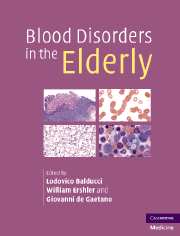Book contents
- Frontmatter
- Contents
- List of contributors
- Preface
- Part I Epidemiology
- Part II Hematopoiesis
- 5 Stem cell exhaustion and aging
- 6 Hematopoietic microenvironment and age
- 7 Replicative senescence, aging, and cancer
- 8 Qualitative changes of hematopoiesis
- 9 Aging and hematopoietic stress
- 10 Immunoglobulin response and aging
- 11 Biological and clinical significance of monoclonal gammopathy
- Part III Anemia of aging
- Part IV Hematologic malignancies and aging
- Part V Disorders of hemostasis in the elderly
- Index
7 - Replicative senescence, aging, and cancer
from Part II - Hematopoiesis
Published online by Cambridge University Press: 21 October 2009
- Frontmatter
- Contents
- List of contributors
- Preface
- Part I Epidemiology
- Part II Hematopoiesis
- 5 Stem cell exhaustion and aging
- 6 Hematopoietic microenvironment and age
- 7 Replicative senescence, aging, and cancer
- 8 Qualitative changes of hematopoiesis
- 9 Aging and hematopoietic stress
- 10 Immunoglobulin response and aging
- 11 Biological and clinical significance of monoclonal gammopathy
- Part III Anemia of aging
- Part IV Hematologic malignancies and aging
- Part V Disorders of hemostasis in the elderly
- Index
Summary
Introduction
One of the fundamental properties of mitotically competent human somatic cells is an innately programmed barrier to unlimited proliferation. This process, known as replicative (or proliferative) senescence, may serve as one of many safeguards to maintain cellular integrity necessitated by the extended longevity of humans. Species such as rodents, which live for only a few years, can protect cells by such functions as DNA repair and antioxidant pathways. In humans, these conventional cellular defense strategies, which might otherwise fail over the many decades of human life, are bolstered by the mechanism of replicative senescence.
It is believed that a restriction in the number of cell divisions may serve as a protection against the potential for multiple mutations that are required for the development of a cancer cell from a cell that is normal. The replicative senescence program is a strict characteristic of human, as opposed to mouse, cells, and in fact there is no documented case of a normal human cell undergoing spontaneous immortalization in cell culture. By contrast, mouse cells transform quite frequently in cell culture, becoming immortal cell lines. Parallel observations have been made in vivo: mice show high rates of cancer within their three-year lifespan, whereas most human cancers occur after age 50.
- Type
- Chapter
- Information
- Blood Disorders in the Elderly , pp. 84 - 94Publisher: Cambridge University PressPrint publication year: 2007

